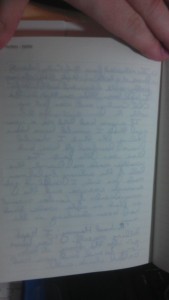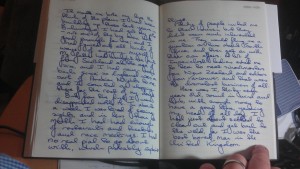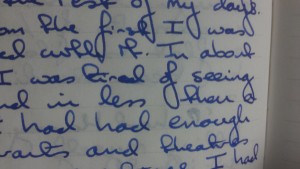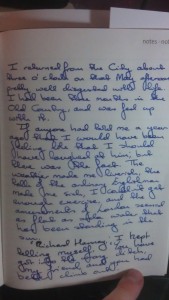CIAK Day-Per-Page Diaries: Paper quality
I’ve been keeping a diary since 1998. With the exception of some real shoddiness between late-2004 and 2006, I’ve done pretty well at maintaining a solid record, which is always satisfying. I started out with a Discworld Diary (and, on digging out that link, am mildly annoyed to discover that if I hadn’t written in it every single day for a year, it would be worth around £110, a sum I imagine is likely to be sorely diminished by my thirteen-year-old scrawl, at least unless I become famous). For quite a long time I was on WH Smith generic page-a-day jobs, which were perfectly acceptable in a choice-between-black-and-silver sort of way, and then I got fussy and started looking for cooler diaries.
Which brings me to Ciak. Ciak do colours which aren’t just black or silver (although they’ve no green. I want a deep green A4 page-a-day Ciak diary for 2014, man at Ciak whose job it is to trawl the Internet for reviews to translate into Italian. Grazie.), and they’re softcover leatherbound things, with a horizontal elastic band (which is rather more useful than the Moleskine vertical-band approach from a tucking-things-in point of view).
And they’re really good value – usually less than £20, for a handmade, leatherbound full-size diary. The paper is eco friendly (if you care about that sort of thing), and more importantly is acid-free (which you should care about, because if you go around keeping a diary on acidic paper it’ll begin to eat itself within the century, which is profoundly unhelpful).
The one criticism I kept seeing around the Internet was a consistent variation on ‘The paper quality is really low in these diaries compared to their notebooks. Ink bleeds straight through’.
Now, this is a problem. In much the same way that a CRT monitor with a refresh rate of <80Hz used to give me headaches, low-gsm paper is one of those things that’s horrible from both a tactile and an aesthetic perspective, especially since my writing is always smoother with a fountain pen. I was particularly bothered by this review suggesting the paper was only about 70gm. But I took a punt on a 2012 diary anyway, because I figured at the price I was paying I could risk getting uselessly thin paper and still have enough pennies left to get another black WH Smith diary if there was a serious problem, and the chance to get an orange diary was too good to not take the risk.
And, in the end, I was really pleased. As Paper Pens Ink observes, the ink does show through, even in biro, but it doesn’t do so in a particularly bleed-y way: it’s possible to see that something is written overleaf, but not to tell what it is, and it doesn’t make the current page unreadable. Sure, the paper could be a little heavier, but it’s not actually that much of a problem.
Anyway, by way of a better blog update than my last one, I thought I’d throw around a few shots of how Ciak diaries cope with fountain pens. I’m on a medium-nibbed Waterman, and I kept the ink pressure higher than I normally would in order to get as much ink on the pages as possible, but I think things turned out OK.
To begin with, here’s a shot of a page filled out (I’m working in the Notes section here, rather than one of the daily pages, but the line spacing is the same in both: pretty wide and with lots of space for both high and low letters. Occasionally a problem on super-busy days, but good enough for most things):
 (Assuming we can forgive me the apparently wonky writing – I was transcribing for speed rather than style! – we’ll see there that there’s no real bleeding going on, and the letters stay more or less where they were put).
I really piled on the ink for this paragraph, which is why the ‘R’ of ‘Richard’ is so thick, but again you’ll notice that’s not really due to bleeding through the grain of the paper; the nib just dumped the ink down and the paper held it there until it dried.
 This is the verso of the page I’ve just written. You can see what Paper Pens Ink was talking about: the in’k from overleaf is clearly showing through (and the ‘Richard Hannay’ paragraph is particularly obvious). But…
This is the verso of the page I’ve just written. You can see what Paper Pens Ink was talking about: the in’k from overleaf is clearly showing through (and the ‘Richard Hannay’ paragraph is particularly obvious). But…
 …As you can see on the left hand side of this double-spread, once you’ve written on both sides of a page, you can’t really tell that the ink used to show through: the writing on this side of the page covers the bleed-through without affecting the legibility of either page.
…As you can see on the left hand side of this double-spread, once you’ve written on both sides of a page, you can’t really tell that the ink used to show through: the writing on this side of the page covers the bleed-through without affecting the legibility of either page.
 Here’s our old friend the ‘Richard Hannay’ paragraph, now written on both sides. You can still see the top of the R showing through clearly, but everything’s still legible (even where I caught my little finger on the ‘tired’!)
Here’s our old friend the ‘Richard Hannay’ paragraph, now written on both sides. You can still see the top of the R showing through clearly, but everything’s still legible (even where I caught my little finger on the ‘tired’!)
I don’t disagree with the argument that Ciak could be using heavier paper in their diaries, but – at least for me – I don’t think it’s so thin that there’s a problem. The ink does show through the page, but that’s only really noticeable for as long as the reverse is blank. Once you’ve written on both sides of the page, the bleed-through isn’t really noticable, and, crucially, it doesn’t affect legibility.
For acid-free paper in a leather cover (and a snazzy looking leather cover at that), Ciak are pushing seiously good value at less than £20. If they were asking more than £30 quid, I’d say the paper quality wasn’t good enough for the price, not least because it’d be up against serious contenders in the £30 – £50 diary bracket, even before the luxury diary market kicks in (yes, there’s such a thing as a luxury diary market), but right now they work for me. Which, let’s be honest, is all I’m likely to worry about in picking out diaries.
Oh, and just in case anyone’s lagging behind in the identification-of-text stakes, what I’ve been transcribing there is the opening paragraphs of The Thirty-Nine Steps. Which is awesome, you should go read that.

